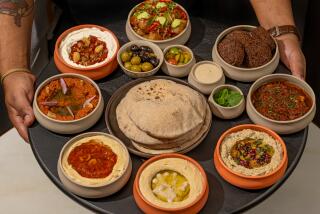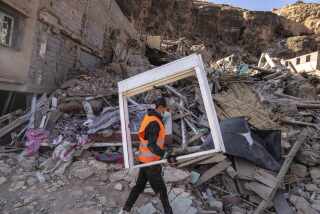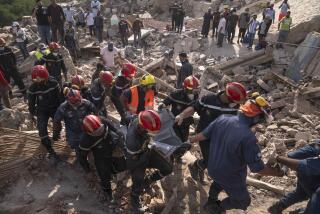A Moroccan Adventure on the Way to Marrakech
- Share via
SETTAT, Morocco — Good planning is supposed to be a key to any successful overseas vacation.
After all, who wants to arrive in, say, Vienna planning to visit its wonderful museums and art exhibits only to discover that your only free day is Monday, when most are closed? And it’s equally distressing to roll into Akita, Japan, the day after its famous Kanto lantern festival ended.
Still, there are those times when pure chance does put you in the right place at the right time. That’s how it was late one morning on the narrow road that was to take us south from Casablanca to Marrakech, Morocco.
It was to be at least a five-hour drive. Once clear of the city, the scenery involved rolling brown hills, mostly covered with the stubble of harvested alfalfa. With nothing particularly interesting to take in, we half dozed as our driver skillfully overtook slower-moving inter-city buses and always overloaded trucks.
Tents in the Distance
Suddenly, off on the horizon appeared an unreal sight. An otherwise flat, uninhabited expanse of field was filled with row after row of tents. Banners and streamers fluttered in the morning breeze from the peaked canvas tops.
It was a moussem , a Moroccan pilgrimage or festival that takes place in each province of the country at varying times throughout the year. A true moussem is among the most colorful, most spectacular events anywhere in North Africa. Yet it is in no way tied to tourism.
Finding out where one of these events will take place, let alone when, is likely to frustrate even the most dedicated traveler to Morocco. Guidebooks often provide such directions as “ . . . go six miles from Casablanca on the road to Bouskowa” or “ . . . drive 32 1/2 miles from Marrakech on the road to Asni. . . .”
So to have stumbled onto a great moussem just a few miles outside the little provincial town of Sellat was sheer luck. The drive schedule to Marrakech went out the window, almost literally, as we shouted to the driver to pull over. A looping U-turn and a detour down a bumpy dirt road took us through a cloud of dust to the heart of this unbelievable instant city.
Tents and Carpets
These were no army-style tents, by any means, but gaily striped affairs. Most were open at the front, with carpets spread out over the dirt furnished with rows of cushioned benches. Dozens of men, mostly wearing the long djellaba robes, their heads swathed in turbans or other headgear, lounged about, swapping stories, taking turns puffing on their water pipes of drinking mint tea.
Before the tents of the most important officials in attendance huge brass trays and couscousiers were displayed, the large conical vessels in which couscous, Morocco’s singularly most popular dish, is prepared.
Perhaps as many as 1,000 men were in attendance at this moussem , living in their tents for nearly a week. (The women mostly stayed in the background, cooking and socializing among themselves.)
There is nothing like this event in Western society but for some idea of what it’s like, you might combine elements of an early American county fair with those of a rodeo.
Equestrian Event
That’s because a feature of most moussems is the spectacle of the fantasia. The word is from the Italian and means “a causing to be seen.” In the Moroccan context, however, it has more a meaning of “showing off” and really refers to an equestrian event, a “power play,” so to speak. It undoubtedly had its beginnings in the desert wars between North African tribes.
The modern fantasia, or to use the Arab word, forocia , meaning “games of the horse,” involves a display of daring horsemanship by a village’s best riders. They are mounted on Arabian stallions outfitted with brilliant saddle blankets, and all sorts of decorative tassels and embroidered tack.
The riders dress in flowing white robes with daggers slung from their sides and each carries a mukkala, an antique-looking muzzle-loading musket. In some events the horsemen race at full gallop, some standing in their saddles, others kneeling, firing wildly into the air as they charge toward the tents of the honored guests and the crowds of enthusiastic spectators.
This exuberant display of horsemanship is also a contest. Typically, the goal of the competition at the Sellat moussem was to determine which team could fire its weapons all at the same time. “To do so is evidence of the unity of the village,” a young English-speaking spectator explained.
The Charge Begins
Sure enough, a team of six to two dozen riders would form at the far end of the competition field, perhaps 200 or so yards away. Once in a line, the charge would begin, horses urged on faster and faster. Then the leader shouts a signal.
There is obviously a prearranged silent countdown. At the right moment, the riders are supposed to fire. Not surprisingly, it’s extremely difficult to achieve any sort of unison in the volley without the customary military-style “ready, aim, fire” sequence.
Generally, some rider lets go first and, by reflex, others shoot, completely spoiling the effect. But there is a team that is more disciplined, has the timing down right, and its volley explodes in a fury of noise and white smoke as a single shot.
As its riders rein up in a flurry of dust and flying pebbles, they are greeted with cheers and the acclaim of the spectators. Little boys rush forward, eager to grab the reins of the snorting steeds while others vie for the right to reload the guns with fresh charges of black powder and the percussion caps.
Visitors Welcomed
If foreign visitors happen upon such a moussem , as my wife and I and our friends did, they are welcomed. But this is no event staged for tourists; it belongs to the people of the province, a celebration of the harvest or, more traditionally, as part of a religious pilgrimage.
The anthropologist Andre Launay wrote, “To see the Moroccans at their traditional best one must go to a moussem . There are moussems for rain, moussems for healing, moussems to exorcise devils who are plaguing the community, and moussems to celebrate a saint’s birthday.”
Good as that advice is, it’s hard to follow; given the infrequency of these pilgrimage-festivals and their rural settings, the average visitor to Morocco doesn’t stand much chance of attending one. Still, there is a compromise.
In and around Marrekech, some of the more colorful features of a real moussem are commercially presented. The largest and perhaps best organized is at a place called Chez Ali, about nine miles outside the city.
A 12-Acre Complex
There an entrepreneur named Ali Ben Fellah built a 12-acre complex complete with a high, crenelated fortress wall. Inside are a dozen tents of the kind found at real gatherings.
Twice a day, tour groups are bused out from Marrakech for lunch or dinner featuring traditional Moroccan fare, the ever-present couscous, roast lamb and kebabs. Authentically costumed groups of folk singers and dancers representing the various regions of Morocco perform for the visitors who are free to snap pictures away to their heart’s content.
Then comes the grand finale of the gathering, a fantasia involving two dozen fierce-looking riders who blaze away with their muzzle-loaders in a spectacle worthy of long desert tradition.
It’s not the same as a true moussem , to be sure. Just the same, it’s close enough to the real thing to send visitors away thrilled and with a bit more appreciation of this land and its people.
More to Read
Sign up for The Wild
We’ll help you find the best places to hike, bike and run, as well as the perfect silent spots for meditation and yoga.
You may occasionally receive promotional content from the Los Angeles Times.






